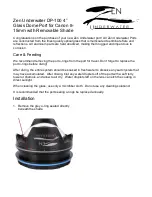
2. intROduCtiOn & COntentS
Power Supply . . . . . . . . . . . . . 220v- 230v 50Hz
Power at 50%. . . . . . . . . . . . . . . . . . . . . 0.8kVA
Max. welding power . . . . . . . . . . . . . . . . 5.5kVA
Max. short circuit current . . . . . . . . . . . . .2500A
Weight . . . . . . . . . . . . . . . . . . . . . . . . . . . 5.2kg
3. teCHniCAl SPeCiFiCAtiOn
4. APPliCAtiOnS
fig. 1
fig. 3
fig. 2
4.1.
nails and washers
A nail or washer, depending on accessibility, is welded to damaged panel to enable the panel to be pulled back into shape with the
slide hammer. See figs. 5 & 6. The washer electrode (fig.1.8) has a magnet to hold the washer in place prior to welding
and should be used in conjunction with extension electrode (fig. 1.11 & fig. 4). When reshaping is completed, cut and
grind off nail or washer to give a smooth finish.
4.2.
Rivets
Rivets are used for attaching mouldings or similar items to panels. The rivet electrode has a magnet to hold the rivet in place
prior to welding (fig. 2).
4.3.
threaded rivets (screws)
Screws are welded to panels to provide mounting points for other equipment (fig. 3).
4.4.
Heating
The heating electrode (fig. 1.10) is used to locally heat and shrink out minor panel defects.
This electrode should be used in conjunction with extension electrode (fig. 1.11).
5. OPeRAting inStRuCtiOnS
WARning!
ensure that you read and understand the safety instructions in Section 1.
introduction
If you are not familiar with the SR20M or with stud welding, we recommend that you practice the following procedure before attempting any actual
task. When welding, you will find that the trigger operation time is very short. Leave approximately 1 minute between each use to allow gun to
cool. Practice on a scrap panel before attempting the actual work. Proceed as follows:
5.1.
Welding
5.1.1. Disconnect from power supply. Screw side handle to left or right side of gun, as required.
5.1.2. Attach the appropriate electrode (see Section 4). If using either of electrodes fig. 1.8 and 10, also fit extension electrode fig. 1.11, see
fig. 4.
note: electrodes are copper, dO nOt over tighten or threads will be damaged.
5.1.3. Ensure you check the following before you start:
a). Electrodes and extension electrode must be clean and without defect. Carefully remove any defect with a fine file or abrasive
paper.
b). If the electrode is too worn and cannot be repaired, replace with a new one.
c). The panel to be welded must be clean and free from paint, grease or rust.
fig. 4
The SR20M Stud Welding Kit is packed complete with a slide hammer and various electrodes. The kit is ideal for fast, efficient body repairs. Removes
dents quickly, without holes, or the need to remove interior trim. The gun is suitable for welding a wide range of nails, washers, screws and rivets. The SR20
(in conjunction with electrodes 10 and 11) may also be used for heat shrinking to remove small dents and pimples in panels. The welder is for professional
use only in an industrial environment. It must not be used for any other purpose, as there could be serious difficulties in assuring the electromagnetic
compatibility in other environments. Further supplies of nails, washers etc. are available from your local dealer.
Contents:
1. Welding Gun.
11. Extension Electrode for use with items 8 &10.
2. Case.
12. Nails Ø2x50.
3. Pull Hammer.
13. Nails Ø2.5x50.
4. Electrode for Ø2 nails.
14. Threaded rivets (screws).
5. Electrode for Ø2.5 nails.
15. Rivets for moulding.
6. Electrode for M4 screws.
16. Washers Ø16.
7. Magnetic electrode.
8. Washer electrode.
9. Washer hook.
10. Heating electrode.
Original Language Version
SR20.V2 Issue: 2 - 12/08/10





















